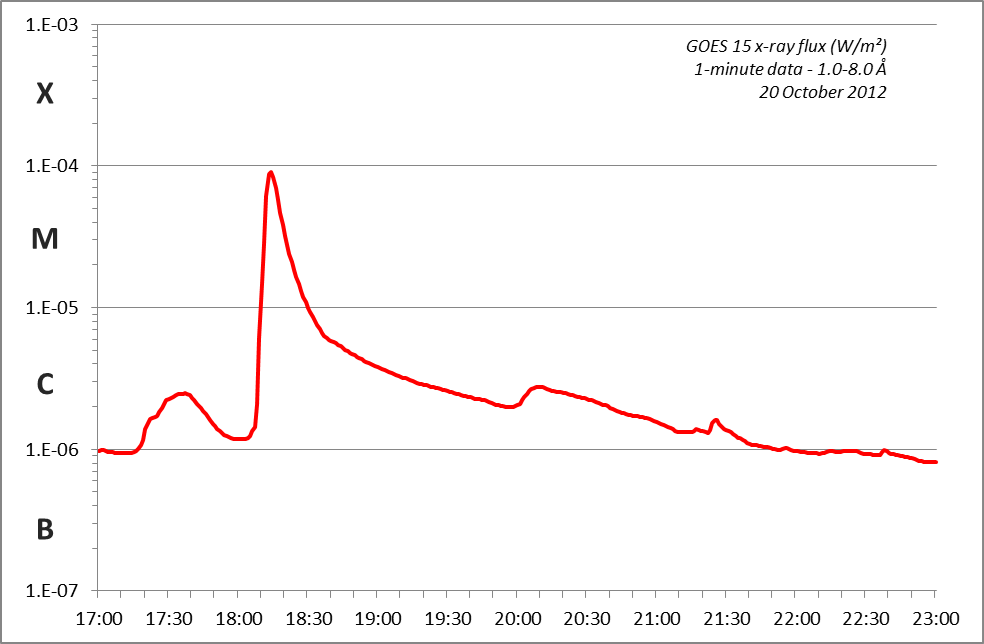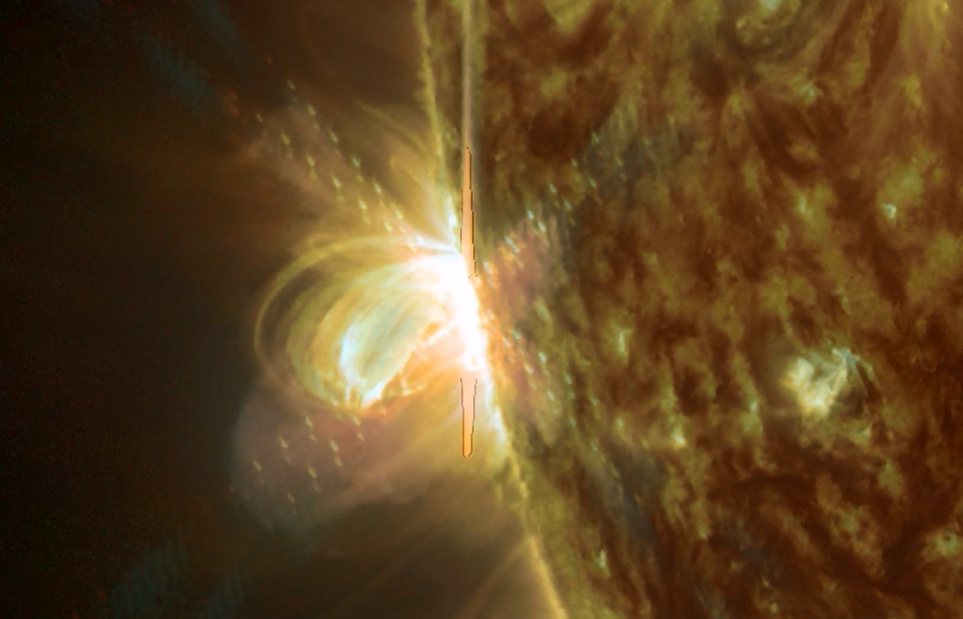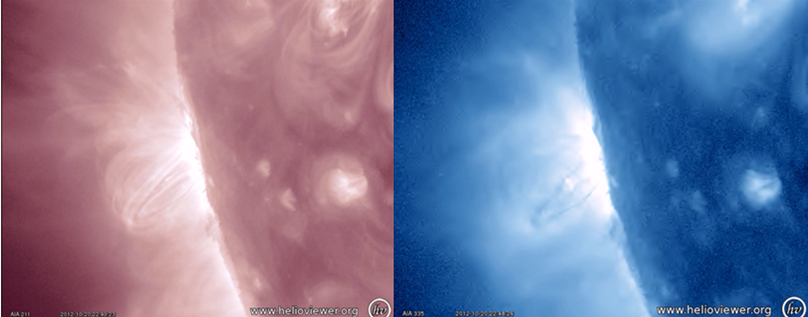
The Solar-Terrestrial Centre of Excellence (STCE) is a collaborative network of the Belgian Institute for Space Aeronomy, the Royal Observatory of Belgium and the Royal Meteorological Institute of Belgium.
 |
Published by the STCE - this issue : 25 Oct 2012. The Solar-Terrestrial Centre of Excellence (STCE) is a collaborative network of the Belgian Institute for Space Aeronomy, the Royal Observatory of Belgium and the Royal Meteorological Institute of Belgium. |
| Archive of the newsletters | Subscribe to this newsletter by mail |
On 20 October, the Sun unleashed an impulsive M9-flare. This flare peaked at 18:14UT in sunspot group NOAA 1598, which was at the time of the blast still partially behind the southeastern solar limb. One already has to go back to 12 July to find an even stronger flare (X1.4 in NOAA 1520).
The flare did not last long: Starting at 18:05UT, it already had come to its end by 18:19UT. No high-energetic protons were released at the time of the flare, and only a slow and weak coronal mass ejection (CME), directed away from Earth, was associated with it.

The SDO-images (http://sdo.gsfc.nasa.gov/ ) provided a quite spectacular view of this flaring active region. A movie (http://www.youtube.com/watch?v=74_JiCN6VO0 ) was created starting with some white light images of NOAA 1598's main spot as it rotated onto the disk. Then follow 4 clips imaging the eruption in successively higher temperatures: 50.000° (AIA 304), 650.000° (AIA 171), 2 million degrees (AIA 211) and 2.5 million degrees (AIA 335). The movie ends with a combo-clip combining imagery from AIA 304, 171 and 131 providing a good view of the event throughout the entire temperature range of the transition region and corona. Each clip covers the time frame from 17:00-23:00UT.

Interesting to see is the appearance, oscillation and disappearance of bright coronal loops inside this active region just prior and during the M9-flare. The appearance of these loops is measured in GOES x-ray data as a C2.4-flare peaking at 17:37UT. Other loops to the north of the active region, already visible before the M9-flare, are also oscillating. In response to the M9-flare, these loops can then be seen oscillating as if they were quivering jelly. Similar to the waves from earthquakes being used as an indirect way to probe the Earth's interior, these oscillations of coronal loops are used to indirectly estimate properties of the Sun's hot atmosphere (e.g. magnetic field,…). This domain of study is called coronal seismology.

Around 19:30UT, the first post-flare coronal loops of the M9-flare can be seen forming a bit to the south of the blast site. During the subsequent hours, they evolve into a fascinating series of ever growing loops.

The higher temperature images (especially AIA 335) do not show the individual coronal loops very well, but quite visible is the formation of dark material. The darkness of this material is an indication that its temperature is substantially less than 2.5 million degrees.

Solar activity has been eruptive featuring 30 C flares throughout the week, and rose to active conditions on October 20, when NOAA AR 11598 produced an M9.1 flare peaking at 18:14 UT. No Earthward CMEs were released.
The week started with a minor geomagnetic storm on October 15, and the geomagnetic field was at quiet levels for the rest of the week.
| DAY | BEGIN | MAX | END | LOC | XRAY | OP | 10CM | TYPE | Cat | NOAA | NOTE |
| 20 | 1805 | 1814 | 1819 | M9.0 | 0 | II/1 | 1598 | ||||
| 21 | 1946 | 2003 | 2020 | S10E76 | M1.3 | SF | 0 | 2 | 1598 | associated CME |
| LOC: approximate heliographic location | TYPE: radio burst type |
| XRAY: X-ray flare class | Cat: Catania sunspot group number |
| OP: optical flare class | NOAA: NOAA active region number |
| 10CM: peak 10 cm radio flux |
Solar Activity
This week, the Sun's activity level was *Low* until the week end. On Saturday and Sunday, a new active region (AR11598) started to appear on the East limb and generated an M9.0 and M1.3 respectively (*Moderate* activity).
In order to view the activity of this week in more detail, we suggest to go to the following website from which all the daily (normal and difference) movies can be accessed: http://proba2.oma.be/ssa.
This page also lists the recorded flaring events.
October 19th
On October 19th, a rather spectacular prominence eruption occurred on the south limb (see images below). First image is a SWAP (174)/AIA (304) combination, generated with HelioViewer. Second image is a SWAP difference image.


Also, along the east limb, quite some activity can be observed from an active region behind the limb.
These events can be seen unfolding here: http://proba2.oma.be/swap/data/mpg/movies/campaign_movies/2012_10_19_00_00_07_2012_10_19_23_50_31_SWAP_174__AIA_304.mp4 (SWAP/AIA movie; HelioViewer) and http://proba2.oma.be/swap/data/mpg/movies/campaign_movies/20121019_swap_diff_SouthLimbEruption.mp4 (SWAP difference movie).
October 20th
On October 20th, the aforementioned active region approached the east limb, thereby better disclosing the intensity of its activity. Even though the AR did not yet round the east limb, it displayed M9.0 flare activity during the evening (see pictures below). First image is a SWAP (174)/AIA (304) combination generated with HelioViewer. Second image is a SWAP difference image.


Movies of this event can be seen here: http://proba2.oma.be/swap/data/mpg/movies/campaign_movies/2012_10_20_16_00_07_2012_10_20_21_58_19_SWAP_174__AIA_304.mp4 (SWAP/AIA movie; HelioViewer) and here: http://proba2.oma.be/swap/data/mpg/movies/campaign_movies/20121020_M90_swap_diff.mp4 (SWAP difference movie).
October 21st
On Sunday, the same active region also generated a (not so visible) M1.3 flare.
Start : 2013-01-14 - End : 2013-01-17
The Atacama Large Millimeter/submillimeter Array (ALMA), an
international partnership of Europe, North America and East Asia in
cooperation with the Republic of Chile, is the largest astronomical
project in existence.
The workshop aims to bring together the ALMA-minded solar
community to discuss solar observational issues with ALMA, solar
science and planned observations with ALMA, and the planning of
solar ALMA observations.
Th workshop is hosted by Astronomy & Astrophysics Group,
and will take place in School of Physics and Astronomy, University
of Glasgow, Room 323, Kelvin Building.
Website:
http://www.astro.gla.ac.uk/~eduard/solarALMA/
Start : 2013-02-04 - End : 2013-02-08
Helioseismology provides tools for imaging structures and mass
flows below the solar surface, and is becoming an essential
technique for understanding the dynamics of solar activities and
developing physics-based forecasts of the solar cycle, emerging
active regions and energy release events. A better understanding is
needed to unravel the effects of the complex interactions of solar
oscillations with the turbulent magnetized plasma
on global and local helioseismology
diagnostics. These effects are particularly challenging in regions
of strong magnetic fields. Numerical simulations of solar MHD waves
and turbulent dynamics give important insights into the complicated
wave and turbulence physics, and provide synthetic data for
verification and validation of helioseismology methods and
results.
The goals of this workshop are to discuss and stimulate further
development of helioseismology methods, solar interior models, and
realistic numerical simulations. These goals are particularly
important for analysis of the continuous data flow from the Solar
Dynamics Observatory, development and verification of
helioseismology methods, and for theoretical interpretation of
observations and inversion results.
Website:
http://sun.stanford.edu/LWS2013/
Start : 2013-04-08 - End : 2013-04-12
The most recent solar minimum, solar cycle 23-24 minimum, was
unusually long (266 spotless days in 2008, the most since 1913),
and the magnetic field at the solar poles was approximately 40%
weaker than the last cycle; and unusually complex (the solar wind
was characterized by a warped
heliospheric current sheet, HCS, and fast-wind
streams at low latitudes: the
fast-wind
threads the ecliptic
more commonly in 2008 than 1996.)
This complexity resulted in many effects observed from Sun to
Earth, with many observations indicating unusual conditions on the
Sun, in the heliosphere
, and in the magnetosphere
, ionosphere
, and upper atmosphere of the
Earth.
This remarkable set of conditions provide the scientific
community with an exceptional opportunity to assess the nature and
structure of a very quiet Sun, and an upper atmosphere relatively
devoid of solar influences, helping to provide a better
understanding of the relative roles of solar activity and internal
variability in the dynamics of the Earth's upper atmosphere and
ionosphere
. Such an understanding requires a
multidisciplinary approach.
The main goal of the conference is to bring together the solar,
heliospheric, magnetospheric, upper atmosphere, and ionospheric
communities to debate and discuss interdisciplinary work and reach
a better understanding of the nature and structure of a very quiet
Sun, and of an upper atmosphere relatively devoid of solar
influences, and in doing so, to help clarify the role of solar
activity in the dynamics and variability of the Earth's upper
atmosphere and ionosphere
relative to the internal
variations.
Website:
http://chapman.agu.org/solarminimum/
Start : 2013-05-06 - End : 2013-05-10
In the last 50 years, helioseismology has made significant
contributions to the knowledge of the Sun's interior physics
and has led the way to asteroseismology. We have now reached an era
where more sophisticated questions are being asked to understand
the subtle properties of the Sun and other stars due to the
synoptic and high-resolution observations available from BISON,
GONG and space missions such as SOHO
, SDO, CoRot and Kepler.
On this occasion, a workshop on the theme of '50 years of the
seismology of the Sun and stars' is being organized to reflect the
progress that has been made as well as to focus on future goals. We
plan to bring together helio- and asteroseismologists, theorists
and observers in a journey that will take us from the interior of
the Sun and its magnetism towards the structure of distant stars
and activity cycles.
Website:
http://www.nso.edu/workshops/2013
Start : 2013-07-16 - End : 2013-07-25
The Summer School Alpbach enjoys 36 years of tradition in
providing in-depth teaching on different topics of space science
& technology, featuring lectures and concentrated working
sessions on mission studies in self-organised working groups. 60
young highly qualified European science and engineering students
converge annually for stimulating 10 days of work in the Austrian
Alps. 4 teams compete to design a space mission judged by a jury of
experts. Students learn how to approach the design of a satellite
mission and explore new and startling ideas supported by experts.
The Summer School 2013 will focus on Space Weather
.
The purpose of the Summer School is to foster the practical
application of knowledge derived from lectures, to develop
organisational and team-work skills and to encourage creativity.
Teams will compete to design the best project, judged by an
independent jury. The teams themselves are responsible for the
selection of the subject of the project and for the team structure
and working methods.
Website:
http://www.summerschoolalpbach.at/
Start : 2013-09-09 - End : 2013-09-14
We gain information about the universe through analysis of the
spectra from celestial objects. However, while the intensity
spectrum represents a scalar quantity but electromagnetic radiation
occurs in the form of transverse waves, the polarized spectrum
provides us with a 4-vector, the Stokes vector. The increased
amount of information space opens new windows to the universe, in
particular for the exploration of magnetic fields. It is well
recognized that the magnetic field is a primary agent responsible
for structuring and the source of all variability on intermediate
time scales, which manifests itself in all forms of solar and
stellar activity.
It is therefore not surprising that every year there are many
scientific meetings organized with the objective of studying the
role of magnetic fields in cosmic objects. What is largely missing
in these meetings is however an in-depth investigation of the
fundamental aspects of how magnetic fields can be determined by the
means of spectro-polarimetry, our main gateway to cosmic magnetism.
The primary aim of our series of Workshops is to address these
fundamental aspects, with less emphasis on the morphological and
physical properties of cosmic magnetic fields.
Website: http://spw7.ynao.ac.cn/
Presentatie over de 24ste zonnecyclus voor leden van de volkssterrenwacht Urania in het kader van hun wekelijkse voordrachten. Een basiskennis is vereist.
http://www.spaceweather.eu/en/repository/show?id=254
Presentatie over de zon voor leden van de volkssterrenwacht MIRA in het kader van een cursus sterrenkunde. Een basiskennis is vereist.
http://www.spaceweather.eu/en/repository/show?id=255
Talk in the session Solar magnetism and the solar cycle
http://www.spaceweather.eu/en/repository/show?id=256
Talk in the session Solar Magnetism and the Solar Cycle
http://www.spaceweather.eu/en/repository/show?id=257
Talk in the session Solar Magnetism and the Solar Cycle
http://www.spaceweather.eu/en/repository/show?id=258
Talk in the session Solar Magnetism and the Solar Cycle
http://www.spaceweather.eu/en/repository/show?id=259
Talk in the session Solar Magnetism and the Solar Cycle
http://www.spaceweather.eu/en/repository/show?id=260
Talk in the session Processes of slow/steady energy release in the solar atmosphere and heliosphere
http://www.spaceweather.eu/en/repository/show?id=261
Talk in the session Processes of slow/steady energy release in the solar atmosphere and heliosphere
http://www.spaceweather.eu/en/repository/show?id=262
Talk in the session Processes of slow/steady energy release in the solar atmosphere and heliosphere
http://www.spaceweather.eu/en/repository/show?id=263
Talk in the session Processes of slow/steady energy release in the solar atmosphere and heliosphere
http://www.spaceweather.eu/en/repository/show?id=264
Talk in the session Processes of slow/steady energy release in the solar atmosphere and heliosphere
http://www.spaceweather.eu/en/repository/show?id=265
Talk in the session Processes of slow/steady energy release in the solar atmosphere and heliosphere
http://www.spaceweather.eu/en/repository/show?id=266
Invited talk in the session Processes of slow/steady energy release in the solar atmosphere and heliosphere
http://www.spaceweather.eu/en/repository/show?id=267
Invited talk in the session Processes of slow/steady energy release in the solar atmosphere and heliosphere
http://www.spaceweather.eu/en/repository/show?id=268
Talk in the session Processes of slow/steady energy release in the solar atmosphere and heliosphere
http://www.spaceweather.eu/en/repository/show?id=269
Invited talk in the session Eruptive processes in the solar atmosphere and their manifestations in the heliosphere
http://www.spaceweather.eu/en/repository/show?id=270
Talk in the session Eruptive processes in the solar atmosphere and their manifestations in the heliosphere
http://www.spaceweather.eu/en/repository/show?id=271
Talk in the session Eruptive processes in the solar atmosphere and their manifestations in the heliosphere
http://www.spaceweather.eu/en/repository/show?id=272
Invited talk in the session Eruptive processes in the solar atmosphere and their manifestations in the heliosphere
http://www.spaceweather.eu/en/repository/show?id=273
Talk in the session Eruptive processes in the solar atmosphere and their manifestations in the heliosphere
http://www.spaceweather.eu/en/repository/show?id=274
Talk in the session Eruptive processes in the solar atmosphere and their manifestations in the heliosphere
http://www.spaceweather.eu/en/repository/show?id=275
Talk in the session Eruptive processes in the solar atmosphere and their manifestations in the heliosphere
http://www.spaceweather.eu/en/repository/show?id=276
Talk in the session Eruptive processes in the solar atmosphere and their manifestations in the heliosphere
http://www.spaceweather.eu/en/repository/show?id=277
Invited talk in the session Eruptive processes in the solar atmosphere and their manifestations in the heliosphere
http://www.spaceweather.eu/en/repository/show?id=278
Talk in the session Eruptive processes in the solar atmosphere and their manifestations in the heliosphere
http://www.spaceweather.eu/en/repository/show?id=279
Talk in the session Eruptive processes in the solar atmosphere and their manifestations in the heliosphere
http://www.spaceweather.eu/en/repository/show?id=282
Talk in the session Data assimilation, visualization and analysis
http://www.spaceweather.eu/en/repository/show?id=283
Invited talk in session Data assimilation, visualization and analysis
http://www.spaceweather.eu/en/repository/show?id=285
Talk in session Data assimilation, visualization and analysis
http://www.spaceweather.eu/en/repository/show?id=286
Talk in session Data assimilation, visualization and analysis
http://www.spaceweather.eu/en/repository/show?id=287
Talk in session Data assimilation, visualization and analysis
http://www.spaceweather.eu/en/repository/show?id=288
Invited talk in session Data assimilation, visualization and analysis
http://www.spaceweather.eu/en/repository/show?id=289
Invited talk given in the Session Solar Magnetism and the solar cycle
http://www.spaceweather.eu/en/repository/show?id=290
Talk in the session Eruptive processes in the solar atmosphere and their manifestations in the heliosphere.
http://www.spaceweather.eu/en/repository/show?id=291
Talk in session Data assimilation, visualization and analysis
http://www.spaceweather.eu/en/repository/show?id=292
Talk given in the Session Processes of slow/steady energy release in the solar atmosphere and heliosphere
http://www.spaceweather.eu/en/repository/show?id=293
Invited talk in the session Eruptive processes in the solar atmosphere and their manifestations in the heliosphere
http://www.spaceweather.eu/en/repository/show?id=294
Talk in the session Eruptive processes in the solar atmosphere and their manifestations in the heliosphere
http://www.spaceweather.eu/en/repository/show?id=295
Talk in the session Eruptive processes in the solar atmosphere and their manifestations in the heliosphere
http://www.spaceweather.eu/en/repository/show?id=280
The propagation behavior of coronal mass ejections (CMEs) in interplanetary (IP) space is mainly influenced by the ambient solar wind flow. The interaction of CMEs with the solar wind can be expressed as drag force and manifests itself to decelerate CMEs that are faster than the ambient solar wind, whereas slower ones are accelerated until the CME speed is finally adjusted to the solar wind speed. With the SECCHI instrument suite aboard STEREO, CMEs can be observed during their entire propagation way from Sun to 1AU. The derived kinematical profile and its changes may be interpreted as interaction with high speed solar wind streams as well as other coronal mass ejections.
http://www.spaceweather.eu/en/repository/show?id=296
http://www.spaceweather.eu/en/repository/show?id=297
Talk in the session Eruptive processes in the solar atmosphere and their manifestations in the heliosphere
http://www.spaceweather.eu/en/repository/show?id=281